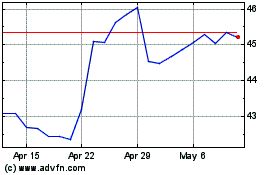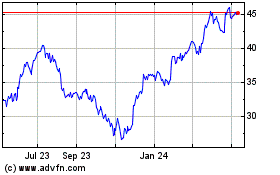Ford Feels Pressure of China Rivals' Pursuit
August 28 2016 - 5:05AM
Dow Jones News
SHANGHAI--When Ford Motor Co. launched the Kuga crossover in
China in 2013, drivers paid extra to have their cars delivered as
soon as possible. Three years later, a backlog of unsold Kugas is
starting to stack up on dealership lots, auto retailers say.
"Even a 20% discount isn't appealing enough" to entice
customers, said Zhang Hui, a small car trader in central Henan
province. Ford sold 18% fewer Kugas in the first half compared with
a year earlier.
Auto makers are under pressure to offer unique products or
services if they want to maintain their share of China's market.
This is particularly acute for Ford, a relative latecomer to China,
because it lags behind rivals Volkswagen AG and General Motors Co.
in terms of product lineup and brand image there, analysts say, as
domestic auto makers are gaining traction.
The Kuga's relatively fast deceleration from being a top seller
in China illustrates the challenges facing foreign auto makers in
the world's biggest auto market, where growth is moderating and
domestic rivals are offering cars with similar technology at lower
prices, putting a squeeze on companies' profit margins. China's
top-selling SUV in the first seven months of the year was Great
Wall Motor Co.'s Haval H6, which starts at under $14,000.
"We're seeing a lot of competition from the domestics that are
really coming up strongly and with really better products," Robert
Shanks, chief financial officer at Ford said on a recent conference
call. The company is responding to declining market share with
several new-model launches in the back half of the year.
This includes a revamped Kuga that has a new grille design, a
more fuel-efficient engine, and a new communications system.
"These are all good selling points. But I dare not say it will
be a certain success," said Xie Zhaohan, an analyst at Ways
Consulting Co. "The small and compact crossover segment is
saturated, and Chinese consumers prefer bigger crossovers to
accommodate their extended families."
China's new-car sales roared from two million vehicles in 2000
to more than 24 million in 2015, but now auto makers are cooling
their ambitions. Toyota Motor Corp. said earlier this year that it
is uncertain about hitting a target it set two years ago to sell
two million cars in China by 2025. Jochem Heizmann, head of
Volkswagen's China operations, said this month that he expects
slower growth in the second half and warned that the expiration
this year of a tax break on small-engine vehicles left an unclear
picture for next year, given that the incentive is helping drive
demand.
Ford unveiled four years ago an ambitious $5 billion plan to
double its production capacity in China by 2015, but it has had
difficulties in the past few months, as noted by senior management
on a recent conference call.
Its Asia-Pacific region, which includes China, swung to an $8
million pretax loss in the second quarter of 2016--its first loss
in the region in 13 quarters--amid a sales decline in China and
weaker pricing. Its China joint venture saw a 28% income drop in
the second quarter, compared with an 8% rise for rival Volkswagen,
although both companies derived lower joint-venture income across
the first half.
A Ford spokesman said the quarterly slide was due to an
eight-week shutdown of one of its plants in southwestern city of
Chongqing for facility upgrades that resulted in 40,000 units of
lost production.
There are bright spots for Ford. First-half sales of its Lincoln
Motor Co. brand in China nearly tripled those of the same period
last year, and the Edge, a higher-end crossover launched last year
and aimed at a different market from the Kuga, has become Ford's
best-selling crossover.
Keeping dealer networks happy in China is another challenge. One
manager of a network of dealerships including Volkswagen, Ford,
Mercedes-Benz and Land Rover based in the southeast city of Wenzhou
said he doesn't feel incentivized enough to sell Ford cars because
sales targets are too high, prompting dealers to heavily discount
cars. "If I can't achieve 100% of the sales target, the bonus won't
be enough to cover my losses," said the dealer, who declined to be
named.
He says he has a Ford inventory level of about 2.2 months of
sales, well above the 1.5 level that is regarded as unhealthy in
China. "When the market was booming, it wasn't very difficult. Now,
it's very difficult," he said.
Ford's spokesman said that the company was happy with its
inventory levels in China, and continues "to work with our dealers
to provide customers with the most clear and compelling offers in
the marketplace."
But the pressure is growing on Ford and its rivals to maintain
share. "Chinese consumers are less loyal to brands than people in
the West," said Peng Bo, a partner with the global strategy
consulting team at PricewaterhouseCoopers.
Rose Yu in Shanghai and Christina Rogers in Detroit
(END) Dow Jones Newswires
August 28, 2016 04:50 ET (08:50 GMT)
Copyright (c) 2016 Dow Jones & Company, Inc.
General Motors (NYSE:GM)
Historical Stock Chart
From Mar 2024 to Apr 2024

General Motors (NYSE:GM)
Historical Stock Chart
From Apr 2023 to Apr 2024
